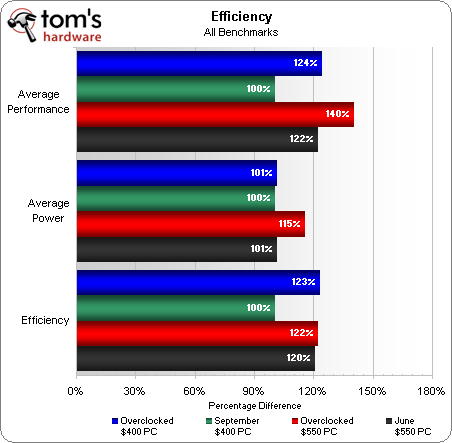System Builder Marathon, Sept. 2010: $400 Gaming PC
Performance Summary And Efficiency
Performance Summary
The $400 PC’s 8% boost to gaming performance would likely have been closer to 18% had we utilized the graphics card’s maximum overclock. We're talking about quite a bit of extra speed that could have been gained by pushing the Radeon HD 5670 to its limit. But in the grand scheme of things, this overclocked machine would still fall far short of the stock $550 gaming rig, sporting its Radeon HD 5770.
The puny boxed cooler limited our four-core processor to 3.2 GHz, tempering the overclocked $400 PC’s dominance over the $550 build in our applications suite. The 28% gain in A/V encoding was countered by small gains in single-threaded iTunes. Meanwhile, 36% gains in our productivity apps are pretty impressive, given just the 200 MHz CPU frequency boost.
Efficiency
Leaving the motherboard's CPU running a higher voltage in our stock testing killed the efficiency of the “un-tweaked” $400 PC. If we’re truly going to put weight into an efficiency measurement, though, it’s about time to make a change and enable power savings features on the budget PC, just as we would with a machine sporting Intel Turbo Boost or AMD Turbo CORE technology.
Get Tom's Hardware's best news and in-depth reviews, straight to your inbox.
Current page: Performance Summary And Efficiency
Prev Page Power Consumption And Temperatures Next Page Conclusion-
SpadeM ReplyGiven the motherboard’s basic passive cooling measures, though, there was really no point in putting more time into lowering the CPU multiplier, pushing a high reference clock, and attempting to maximize northbridge and memory frequencies.
+1 for making this statement, glad someone considered it at least. All in all decent build for the money. -
AMW1011 I'll be honest, I think a $450 budget is a little more reasonable than a $400 budget. At that price a 5750 or even a 5770 can be had, which would have worked fine with all of the other parts and likely would have matched the $550 June build.Reply
Even this $400 build packs a punch, you can get one HELL of a rig for the money any more. It really is insane, and that's not even considering the used or refurb market!
Awesome article, probably one of my favorite SBM, atleast the best I've seen in a long time. -
micr0be very nice build, interesting to see how much performance can be squeezed out of the budget. i was expecting worse results.Reply -
Gamer-girl ReplyIt went $1 over-budget if we substituted in a GeForce 9800 GT.
I doubt someone spending $400 can't afford to add an extra dollar. although i realize that the point in these articles is to stay under the budget, it would have been interesting to see the price/perforamce difference. -
haplo602 nice case, looks very good ... pity that rosewill does not have a downloadable manual for it ...Reply -
HibyPrime I'd be interested to know how much more overclocking headroom you could pull out of it if you left it at 3 cores - and would that net you more performance in most of the benchmarks?Reply
I'd bet if you could pull ~200 mhz more out of it, it would begin to match up with the missing core, and maybe start to pull away around 400mhz. -
Proximon The Cooler Master Elite 460 is a falsely labeled piece of crap. You can find the review (with proper testing) here: http://www.hardwaresecrets.com/article/1005/1Reply
You'll have to spend a little bit more there. Rosewill has a 430W (RG430 S12) unit or the Antec Neo 400W is almost the same price as the CM after a discount and rebate.


